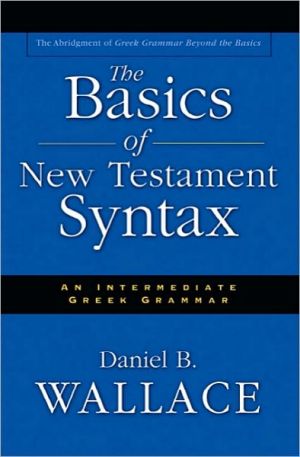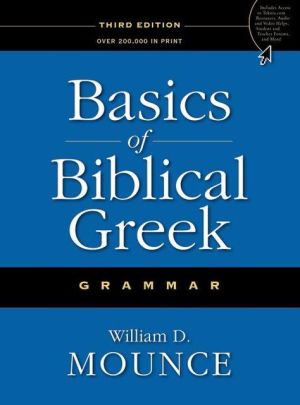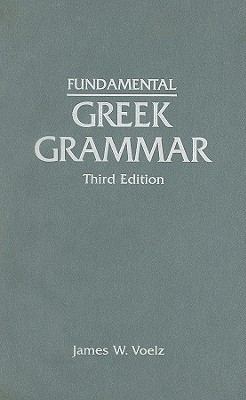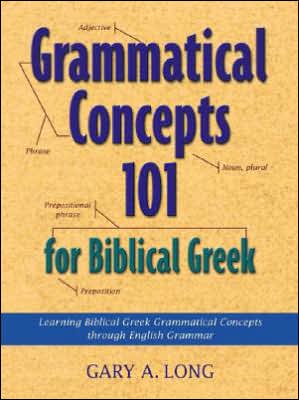The Basics of New Testament Syntax
The Basics of New Testament Syntax provides concise, up-to-date guidance for intermediate Greek students to do accurate exegesis of biblical texts. Abridged from Greek Grammar Beyond the Basics: An Exegetical Syntax of the New Testament, the popular exegetical Greek grammar for studies in Greek by Daniel B. Wallace, The Basics of New Testament Syntax offers a practical grammar for second-year students.\ The strengths of this abridgment will become quickly apparent to the user:\ * It shows the...
Search in google:
An abridgment of the award-winning standard reference grammar of New Testament Greek, Greek Grammar Beyond the Basics, for use in intermediate Greek courses.
The Basics of New Testament Syntax\ An Intermediate Greek Grammar \ \ By Daniel B. Wallace \ Zondervan\ Copyright © 2000 Zondervan\ All right reserved.\ ISBN: 0-310-23229-5 \ \ \ \ Chapter One\ The Nominative Case Overview of Nominative Uses \ Primary Uses of the Nominative 29\ 1. Subject 29\ 2. Predicate Nominative 30\ 3. Nominative in Simple Apposition 33\ Grammatically Independent Uses of the Nominative 34\ 4. Nominative Absolute 34\ 5. Nominativus Pendens (Pendent Nominative) 34\ 6. Parenthetic Nominative (Nominative of Address) 35\ 7. Nominative for Vocative 35\ 8. Nominative of Exclamation 36\ INTRODUCTION: UNAFFECTED FEATURES\ The nominative is the case of specific designation. The Greeks referred to it as the "naming case" for it often names the main topic of the sentence. The main topic in a sentence semantically is, of course, very similar to the syntactical subject, but the two are not always identical. Hence, the most common use of the nominative case is as subject. The nominative occurs more than any other case form in the NT, though the accusative and genitive are not far behind.\ SPECIFIC USES\ Primary Uses of the Nominative ExSyn 38-49\ 1. Subject ExSyn 38-40\ a. Definition. The substantive in the nominative case is frequently the subject of a finite verb. The verb may be stated or implied. Conversely, the subject may be implied, "embedded," as it were, in the verb (e.g., [TEXT NOT REPRODUCIBLE] means "he comes"). This usage is the most common for the nominative case.\ b. Amplification\ Relation to verb voice. The relation of the subject to the action or state of the verb is largely determined by the voice of the verb. If the voice is active, the subject does the acting; if passive, the subject is acted upon; if middle, the subject acts on itself or in its own behalf, or the stress is placed on the subject. There are, of course, exceptions to this: e.g., the deponent middle and passive have active meanings, and the equative verb does not imply action, but a state.\ Relation to verb type. In addition to analyzing verbs by their voice, it is profitable to analyze them as to whether they are transitive, intransitive, or equative. Briefly, transitive verbs take a direct object and can typically be transformed into a passive construction ("the boy hit the ball" can become "the ball was hit by the boy"). Intransitive verbs do not take a direct object and cannot be transformed into a passive ("she came to the church" cannot be changed to "the church was come to by her"). Equative verbs are somewhat in between: they function like transitive verbs in that there are typically two substantives joined by a verb. But they also function like intransitives in that they cannot be transformed. They are unlike either in that the second substantive will be in the same case as the first substantive ("John was a man"). It is important to keep these verb types in mind as you think about syntax in general.\ Missing elements. The verb (especially the equative verb) may be absent from the clause, though implied (e.g., [TEXT NOT REPRODUCIBLE] ["I am a voice"] in John 1:23). Also, the subject may be absent, though implied in the verb (e.g., [TEXT NOT REPRODUCIBLE] ["they were bringing children to him"] in Mark 10:13).\ c. Illustrations\ John 3:16 [TEXT NOT REPRODUCIBLE] God loved the world Rom 6:4 [TEXT NOT REPRODUCIBLE] Christ was raised from the dead\ 2. Predicate Nominative ExSyn 40-48\ a. Definition. The predicate nominative (PN) is approximately the same as the subject (S) and is joined to it by an equative verb, whether stated or implied. The usage is common. The equation of S and PN does not necessarily or even normally imply complete correspondence (e.g., as in the interchangeability of A=B, B=A in a mathematical formula). Rather, the PN normally describes a larger category (or state) to which the S belongs. It is important to keep in mind, however, that there are two distinct types of S-PN constructions; these will be discussed below.\ b. Amplification\ The kinds of verbs used. The verbs used for this "equation" are, most frequently, [TEXT NOT REPRODUCIBLE], and [TEXT NOT REPRODUCIBLE]. In addition, the passives of some transitive verbs can also be used: e.g., [TEXT NOT REPRODUCIBLE].\ Translation of subject-predicate nominative clauses. English translation requires that the S be translated first. Such is not the case in Greek. In John 1:1, for example, [TEXT NOT REPRODUCIBLE] should be translated "the Word was God" rather than "God was the Word." But since Greek word order is far more flexible than English, this creates a problem: How do we distinguish S from PN if word order is not a clear guide? The following section will offer a solution.\ The semantics and exegetical significance of the subject-predicate nominative construction.\ (1) Two Kinds of Semantic Relationships\ The significance of the S-PN construction affects more than mere translation precisely because S and PN do not normally involve total interchangeability. The usual relationship between the two is that the predicate nominative describes the class to which the subject belongs. This is known as a subset proposition (where S is a subset of PN). Thus the meaning of "the Word was flesh" is not the same as "flesh was the Word," because flesh is broader than "the Word." "The word of the cross is foolishness" (1 Cor 1:18) does not mean "foolishness is the word of the cross," for there are other kinds of foolishness. "God is love" is not the same as "love is God." It can thus be seen from these examples that "is" does not necessarily mean "equals."\ But there is another, less frequent semantic relationship between S and PN. Sometimes called a convertible proposition, this construction indicates an identical exchange. That is to say, both nouns have an identical referent. The mathematical formulas of A=B, B=A are applicable in such instances. A statement such as "Michael Jordan is the greatest basketball player in NBA history" means the same thing as "the greatest player in NBA history is Michael Jordan." There is complete interchange between the two. These two kinds of relationships are graphically represented in chart 4 below.\ Thus in examining S-PN clauses, two fundamental questions need to be answered: (1) How can we distinguish between S and PN since word order is not an infallible guide? (2) What is the semantic relationship between the two: Is the S a particular within the larger class of the PN, or is it interchangeable with the PN?\ (2) How to Distinguish Subject from Predicate Nominative\ The general principle for distinguishing S from PN is that the S is the known entity. This principle is valid for both kinds of S-PN constructions. In Greek\ (Continues...)\ \ \ \ \ Excerpted from The Basics of New Testament Syntax by Daniel B. Wallace Copyright © 2000 by Zondervan. Excerpted by permission.\ All rights reserved. No part of this excerpt may be reproduced or reprinted without permission in writing from the publisher.\ Excerpts are provided by Dial-A-Book Inc. solely for the personal use of visitors to this web site. \ \
Table of Contents Illustrations Abbreviations Preface The Language of the New Testament Syntax of Words and Phrases Part I: Syntax of Nouns and Nominals The Cases The Cases: An Introduction Nominative Case Vocative Case Genitive Case Dative Case Accusative Case The Article Part I: Origin, Function, Regular Uses, Absence Part II: Special Uses and Non-Uses of the Article Adjectives Pronouns Prepositions Part II: Syntax of Verbs and Verbals Person and Number Voice Active Middle Passive Mood Indicative Subjunctive Optative Imperative Tense The Tenses: An Introduction Present Imperfect Aorist Future Perfect and Pluperfect The Infinitive The Participle Syntax of the Clause Introduction to Greek Clauses The Role of Conjunctions Special Studies in the Clauses Conditional Sentences Volitional Clauses (Commands and Prohibitions)Subject Index/Cheat Sheet Scripture Index







